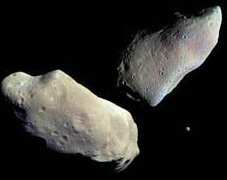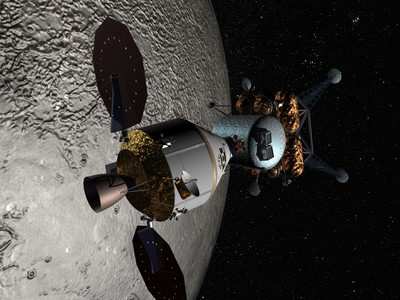NASA Says Such A Mission Would Have Many Benefits
 You may have seen it first on the
big screen, but NASA says a manned mission to visit an asteroid
isn't as far-fetched as it seems. Experts at several locations are
currently outlining the details and requirements of just such a
mission.
You may have seen it first on the
big screen, but NASA says a manned mission to visit an asteroid
isn't as far-fetched as it seems. Experts at several locations are
currently outlining the details and requirements of just such a
mission.
The far-out mission planning just happens to coincide with
NASA's wrap up of its Near Earth Object (NEO) report directed by
Congress. Lawmakers asked NASA how it might catalog dangerous
asteroids zipping around the solar system, and to detail how it
might deal with an asteroid known to be on a collision course with
Earth.
NASA engineers say a visit to an asteroid would have other
benefits for mankind as well.
Carlton Allen, and official with NASA's Johnson Space Center
told Space.com the agency is conducting a feasibility study for a
human visit to an asteroid. "It would involve flying people to one
of the NEOs and, among other things, collect samples and bring them
back," he said.

Experts say the agency already has some of the hardware it needs
in development. The Constellation program is NASA's bid to get man
back to the Moon and on to Mars -- the same hardware could get man
to an asteroid.
In fact, engineers say a mission to an asteroid would be an
ideal trial run for the Orion spacecraft. It would also be a good
way for NASA to work out the kinks for missions beyond Earth's
orbit. For example: communications are almost instantaneous with
orbiting craft. As you get farther from Earth, the communication
delay will grow posing new problems for crews both in space and on
the ground.
Early speculation by engineers suggests an Orion spacecraft
might rendezvous with an asteroid allowing the crew to deploy
remote-control devices to collect samples and conduct other
experiments.

So why not just send a robot? For the same reason as always says
veteran shuttle and international space station astronaut Edward
Lu, "A human flying something remote-controlled is way smarter than
anything you can program. You could look for interesting spots on
the asteroid and make real-time decisions."
The biggest planning issue so far seems to be locating a
suitable... ahem... rock. According to Lu, "We're talking about an
object that's more than likely just 330 feet (100 meters) across,
or less. We're talking a big rock or probably a big rubble pile,
and likely rotating."
And size isn't the only consideration. It will have pass near
enough and slowly enough by Earth for the mission to be
possible.
If NASA's NEO initiative is approved by Congress it will begin
looking much more carefully for a candidate object. Scientists
believe the discovery rate under the new program will be 40 times
the current rate making finding a suitable objects much easier.

NASA says whatever other benefits are gained from such a
mission, at its base it's about survival. Agency administrator
Michael Griffin recently told an audience that, "...our species
hasn't been around long enough to have experienced a cataclysmic
extinction event. But they will occur again, whether we are ready
for them or not..." and in the end "...human expansion into our
solar system is fundamentally about the survival of the species,
about ensuring better odds for our survival through the
promulgation of our species."
Next year NASA will co-sponsor the 2007 Planetary Defense
Conference set to convene in Washington DC. There, the agency hopes
to bring to the table a credible plan for a manned asteroid mission
in support of conference goals.
William Ailor of The Aerospace Corporation in El Segundo,
California and general chair of meeting said, "I think it's
becoming more of a credible issue now. People recognize that these
kinds of events can happen...and we actually have the capability
now to do something about it. The [space] community -- and I would
include the political community -- is beginning to take this more
seriously. We've progressed a long way over the last few
years...but we still have a long way to go."
 ANN's Daily Aero-Linx (04.16.24)
ANN's Daily Aero-Linx (04.16.24) Aero-News: Quote of the Day (04.16.24)
Aero-News: Quote of the Day (04.16.24) Airborne 04.10.24: SnF24!, A50 Heritage Reveal, HeliCycle!, Montaer MC-01
Airborne 04.10.24: SnF24!, A50 Heritage Reveal, HeliCycle!, Montaer MC-01 Airborne 04.12.24: SnF24!, G100UL Is Here, Holy Micro, Plane Tags
Airborne 04.12.24: SnF24!, G100UL Is Here, Holy Micro, Plane Tags Airborne-Flight Training 04.17.24: Feds Need Controllers, Spirit Delay, Redbird
Airborne-Flight Training 04.17.24: Feds Need Controllers, Spirit Delay, Redbird






